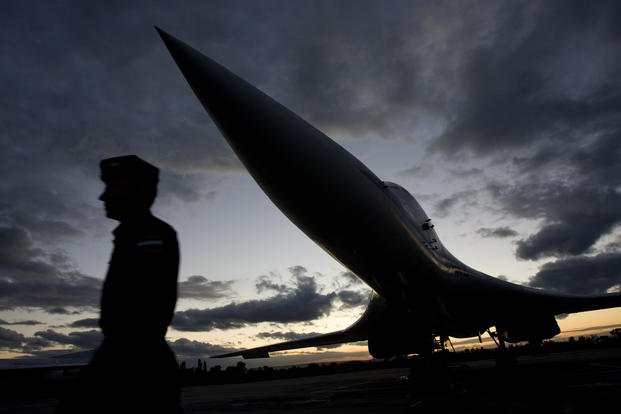DUCK AND COVER
Why Are NATO and Russia Both Now Training for Nuclear War?

We should be deeply concerned that, in the midst of what U.S. President Joe Biden has described as the greatest risk of Armageddon since the Cuban missile crisis, Russia and NATO are this week conducting virtually simultaneous exercises of their nuclear forces, including live (conventional) missile launches. Both Biden and Russian President Vladimir Putin no doubt believe the risks involved in signalling their resolve this way are manageable, but experience during the Cold War suggests otherwise.
Clearly, Putin would not use a tactical nuclear weapon against Ukraine if he believed it would ultimately lead to a nuclear exchange with the United States. That would be suicidal for the Russian regime, to say nothing of the broader global implications. But even threatening their use or conducting military exercises in a crisis can trigger events that rapidly increase the risk of a wider war. Richard Ned Lebow, an expert on nuclear risk, has identified three primary paths by which this can occur: pre-emption, miscalculated escalation and loss of control.
Pre-emption refers to the dynamics in a crisis in which neither side may want a war but each fears an imminent attack by the other and feels compelled to strike first to prevent a disadvantageous outcome. Of course, there's no significant advantage to either side in striking first in an all-out nuclear war, but leaders may be convinced that advantages exist at lower levels of warfare.
Strategist Thomas Schelling's work on this issue is particularly notable, and cycles of mutually reinforcing belief in imminent attack are possible whenever the element of surprise confers significant advantage.
The risks around NATO's 1983 Able Archer exercise may have come close to triggering such a pre-emptive escalatory cycle. For a range of reasons, Soviet intelligence analysts and political leaders believed the exercise was preparation for a NATO first strike against the USSR, and they started preparing for it.
Miscalculation refers to crossing a threshold in the mistaken belief that the action will be tolerated by the adversary. Two good examples are the American decision to march north of the 38th parallel in Korea in 1950, and Argentina's invasion of the Falkland Islands in 1982. Both led to responses that had not been considered likely -- Chinese entry into the Korean War, and a determined British campaign to retake the islands.
Loss of control might occur for any number of reasons. Military preparations or procedures might be poorly understood by political leaders, and certain steps taken by one side to defensively heighten readiness might be interpreted by the other as an offensive move. Their early warning and intelligence systems might misread force-posture changes in the adversary, leading one side to increase its own alert levels, which then triggers the other to do the same. The two sides can become locked in an action–reaction feedback loop.
Perhaps the classic example of loss of control is the July crisis of 1914, although it unfolded at a much slower pace than would be the case today with nuclear-armed adversaries. Statesmen and generals made deliberate decisions, including choices to accept or seek 'limited' war. But mutual and interacting mobilisations contributed to the outbreak of a world war in a 'quasi-mechanical manner'.
Failures of technology can also lead to loss of control. In 1960, U.S. early warning systems incorrectly interpreted with high certainty that the rising moon was a Soviet nuclear missile attack. Fortunately, decision-makers correctly identified it as an error. Vastly improved early warning systems would make that sort of error highly unlikely today, although other technological vulnerabilities continue to exist.
A profoundly worrying risk of loss of control relates to the interplay between restrictions placed on nuclear weapons to prevent their accidental or unauthorised use in peacetime (known as 'negative controls') and the systems to ensure their authorised use in crises ('positive controls'). As a nuclear state seeks to prepare forces for potential use -- or simply prepares them to signal resolve to an adversary, without the intention to employ them -- the balance of controls shifts from negative to positive measures.
Under typical peacetime conditions, many nuclear states physically separate warheads and delivery systems. That's not true of all systems; nuclear ballistic missile submarines are a critical case here. But states don't tend to have bombers sitting on the tarmac with nuclear missiles or free-fall weapons already loaded. Examples of positive controls include the protocols and codes through which release authority is communicated and targets confirmed.
At a heightened state of readiness, with warheads married to delivery systems and various potential delivery systems physically dispersed and held at shorter and shorter notice, these positive controls assume much greater relative importance. In effect, the 'safety catches' are gradually released, increasing the capacity to launch and the risk of accidents.
The range of escalation options open to Russia is broad and has been repeatedly parsed over the past eight months. Putin could conventionally target Western supply lines at a border location or conduct a nuclear test in the Artic, or even the Black Sea, as a signal. He could also 'jump rungs' on the so-called escalation ladder and use a relatively small 'tactical' nuclear weapon, either demonstratively on Ukrainian territory or on military targets.
Pre-emption, miscalculation and loss of control -- and their linkages -- could well play out in the lead-up to or aftermath of any of these actions.
Putin may simply not believe that an American-led response would follow a given escalatory action by Russia. Or he could believe that the response would be limited enough to be tolerable. That is, he could miscalculate.
Or, if Putin used a tactical nuclear weapon and the U.S. responded with large-scale, conventional strikes as signalled by retired American general David Petraeus recently, the risks of loss of control and pre-emption might both increase. Russian military leaders might misread preparations for conventional strikes against battlefield targets in Ukraine as instead positioning for strikes on Russia's leadership or command-and-control systems.
Other factors could interact with this kind of escalatory dynamic. We are currently experiencing a heightened period of solar flare or 'sunspot' activity, which has historically interfered with satellites, as well as with terrestrial high-frequency radio. One hopes Russian and American systems have been hardened to withstand this well-known problem, but it is emblematic of any number of prima facie unlikely factors that could contribute to catastrophic escalation.
In 1963, the year after the Cuban missile crisis, U.S. President John F. Kennedy gave a speech professing his commitment to peace. Among many remarks that resonate nearly 60 years later, Kennedy observed: '[N]uclear powers must avert those confrontations which bring an adversary to a choice of either a humiliating retreat or a nuclear war. To adopt that kind of course in the nuclear age would be evidence only of the bankruptcy of our policy or a collective death wish for the world.'
Putin's humiliation is Putin's doing, and Ukraine is understandably committed to reconquering its own territory. Paths must be found despite these realities that avert the spectre of the worst possible outcome for Ukraine, Russia and the rest of the world. A good starting point would be for leaders to understand that the risks of nuclear escalation are likely to be even greater than they have assumed.
William Leben is an analyst on secondment to ASPI (where this first appeared) from the Australian Army. The views expressed in this article are those of the author and do not necessarily reflect the position of the Department of Defence, the Australian Army or the Australian government.
This article originally appeared on 19fortyfive.com.









.jpg)
